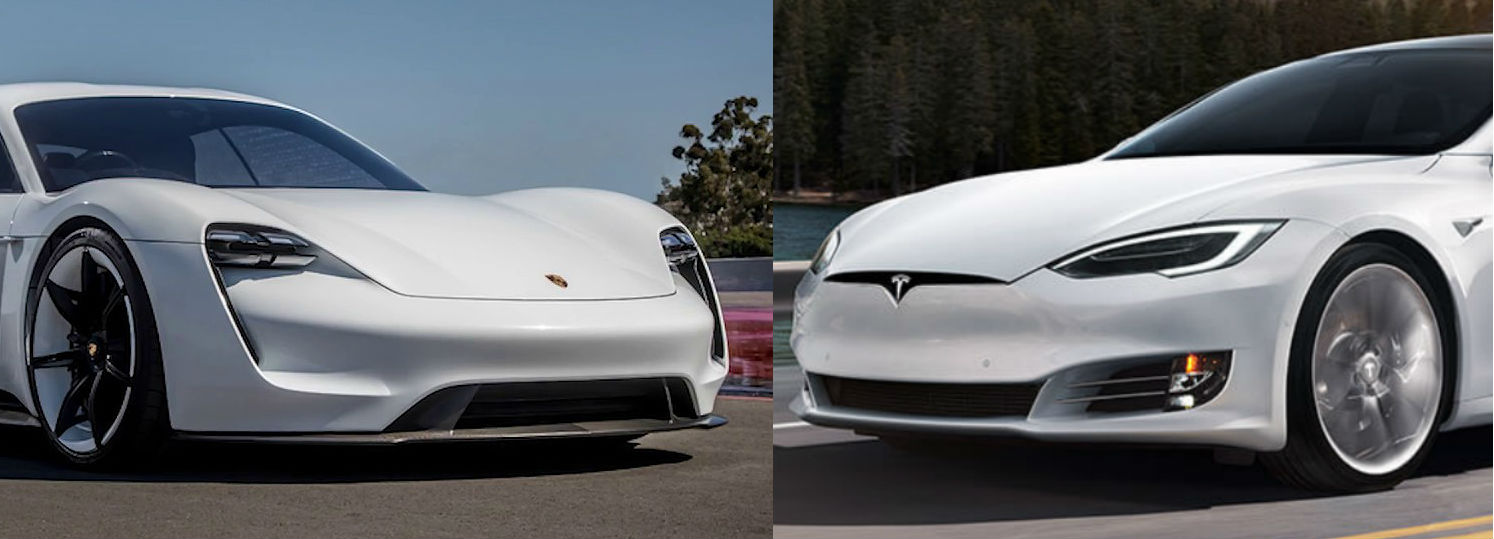

News
Porsche Taycan vs Tesla Model S: Powertrain, battery, performance, and features
The Tesla Model S has been sitting on top of the full-sized electric sedan market for a while now — and for good reason. The vehicle, after all, has played a huge part in changing the public’s perception of what electric cars are capable of. Fast, sleek, and equipped with real range, the Model S is a true no-compromises vehicle.
Among all the competitors for the Model S, there is one that is being developed to compete directly with the electric car. That is the Porsche Taycan, formerly known as the Mission E sedan. The Taycan made its debut during the 2015 Frankfurt Motor Show, and it has captured the imagination of EV enthusiasts ever since. Porsche is yet to unveil the production version of the Taycan, though it has several camouflaged units doing real-world tests today.
Porsche appears to be a legacy automaker that is really serious about making the Taycan a successful vehicle — so much so that the company actually released the car’s specs earlier this year. That said, how does the Taycan compare to the golden standard of four-door electric sedans? Here’s a brief comparison.
Powertrain
The Tesla Model S was initially released with an RWD option, though all variants of the vehicle today are now Dual Motor AWD. The Model S uses three-phase, four pole AC induction motors with copper rotors as its powertrain. The car is also equipped with a drive inverter with variable frequency drive and regenerative braking system.
In contrast, Porsche is using permanently excited synchronous motors (PSM) for the Taycan. In true Porsche tradition, the PSM motors are race-bred, having been used in the Porsche 919 Hybrid racecar. Naser Abu Daqqa, Porsche’s director of electric drive systems, notes that the coils used in the Taycan’s PSM motors are “made of wires that aren’t round, but rather rectangular, making it possible to pack the wires more tightly and get more copper into the coil machines—increasing power and torque with the same volume.”
Batteries and Charging
Tesla’s battery packs hold the standard as some of the finest in the industry. With the Model S, Tesla is using 75 kWh or 100 kWh microprocessor controlled, lithium-ion batteries. The Model S also uses 18650 cells as the components of its packs, which allow the vehicle to reach up to 315 miles per charge. The Tesla Model S is fully compatible with the ~120 kW Supercharger Network, which currently has more than 10,900 stalls worldwide.
The Porsche Taycan is set to use lithium-ion batteries as well. In a press release about the vehicle, the German legacy automaker noted that it would use 4-volt cells in the Taycan’s 800-volt battery pack. Porsche is designing the Taycan for rapid charging at speeds of up to ~350 kW through the upcoming IONITY Network, whose initial construction is underway.
The Porsche Taycan track testing at the Nurburgring.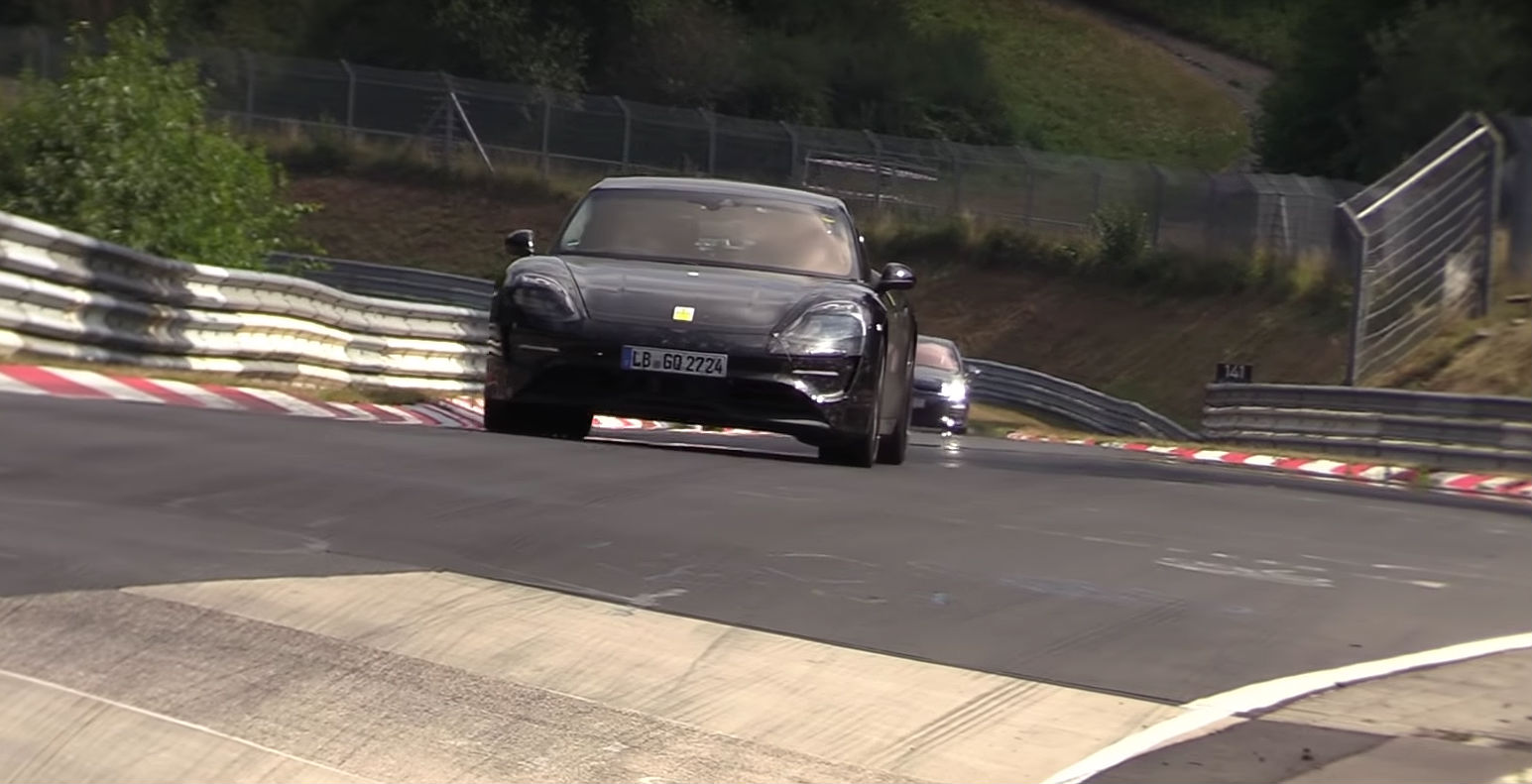
Performance
The Tesla Model S has a reputation for being a family sedan that can humiliate supercars on the drag strip. The Model S P100D, the vehicle’s top trim, is capable of going from 0-60 mph in just 2.4 seconds with its Ludicrous Mode upgrade. The vehicle’s top speed is software-limited to 155 mph.
Porsche notes that the Taycan would have a 0-60 mph time of 3.5 seconds and a top speed of 155 mph. While this is not as quick as the top-tier Model S P100D, Porsche maintains that the Taycan would be able to handle extended track driving — an area that the Model S does not excel in. Porsche appears to be putting its foot where its mouth is with the Taycan’s track capabilities, as the vehicle has been spotted testing in the Nurburgring multiple times over the past few months.
Software
Tesla is noted for its Autopilot driver-assist system and firmware updates that add features to its vehicles. This was particularly exhibited last year when the company opted to “uncork” the 75D and 100D variants of the Model S and Model X, which lowered the vehicles’ 0-60 mph times. Tesla CEO Elon Musk also noted during the company’s Q2 2018 earnings call that Software V9 would be coming soon, which should introduce the first features of Tesla’s Full Self-Driving suite.
Porsche plans to feature the same system for the Taycan. In an interview with Autocar at the Geneva Motor Show, Porsche chairman Oliver Blume stated that the automaker is also looking to give the Taycan (then called the Mission E sedan) firmware upgrades that improve the car’s performance. Blume also alluded to some degree of self-driving for the vehicle, stating that “there are situations in traffic jams where you will be able to read a newspaper, but our customers take pleasure from driving and this will remain.”
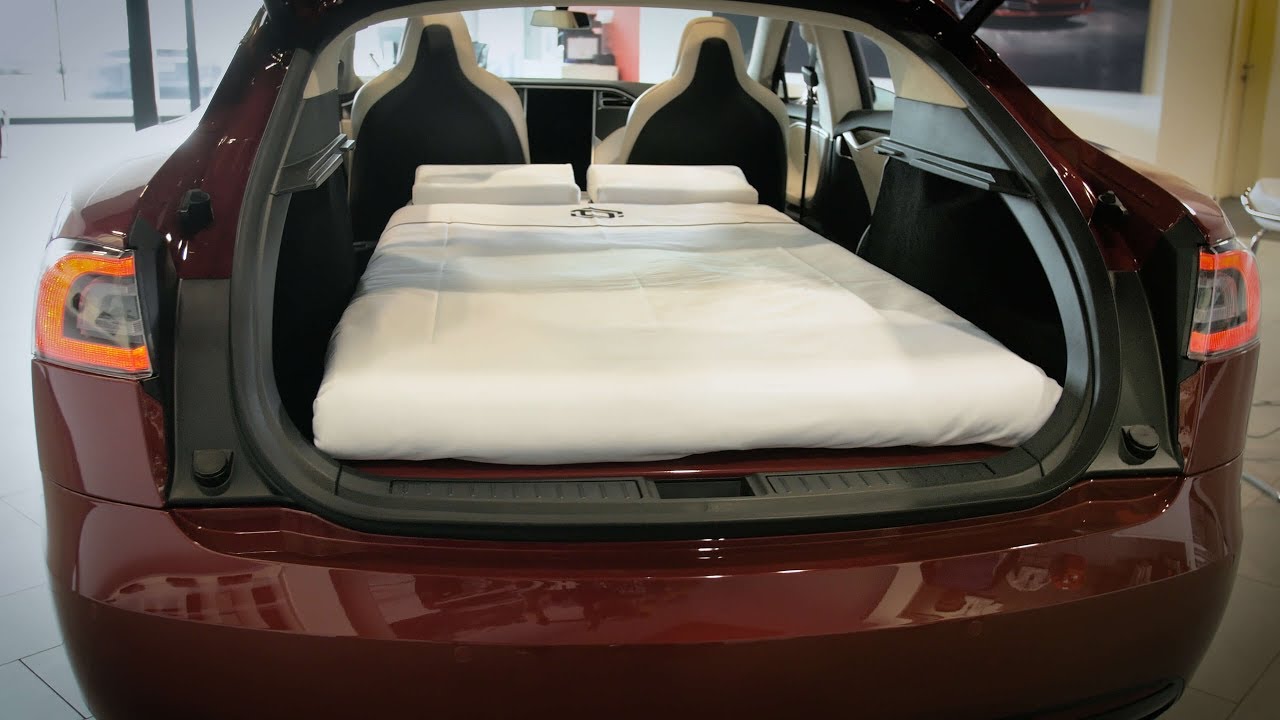
Cargo Space
The Tesla Model S features a lot of space for cargo. The vehicle has a total cargo volume of 31.6 cu ft, comprised of 5.3 cu ft in the frunk, and 26.3 cu ft at the rear. With the back seats folded, the Model S features a very spacious 58.1 cu ft, which is enough to fit an inflatable twin mattress, for those times when drivers would prefer to sleep in their vehicles.
Porsche has not revealed the storage capacity of the Taycan yet, but Stefan Weckbach, the head of electric vehicles at the company, did mention that the car would have 100 liters of storage in the frunk. That’s about 3.53 cu ft, which is smaller than the Model S.
Price
The Model S 75D (the current base model) starts at $74,500, though higher trims like the supercar-slaying P100D could cost as much as $135,000. On the other hand, Porsche expects the Taycan to start at around the ~$75,000 – $85,000 range, putting it close to the price of an entry-level Panamera.
Availability
The Tesla Model S is currently available for purchase, though there are rumors that a refresh featuring an updated interior would be rolled out within the next few quarters. The Porsche Taycan, on the other hand, is expected to start production sometime in 2019, with deliveries likely hitting their stride around 2020.
News
Tesla opens massive solar Supercharger station in California
The Supercharger opened to customers ahead of Fourth of July weekend, while Tesla continues phase two of construction on the site.
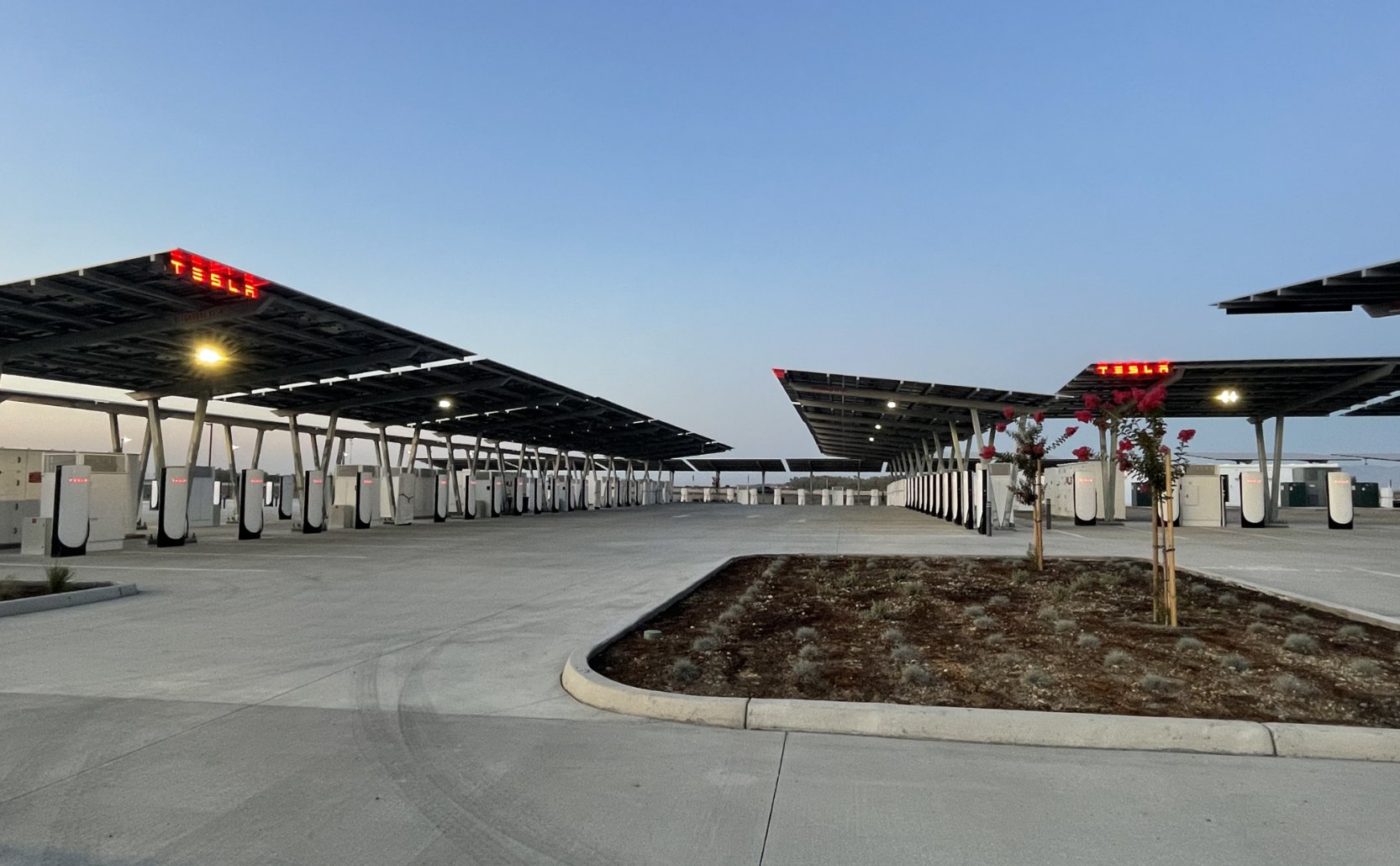
Tesla has officially launched the first several Supercharging posts at a massive station in California, notably including solar canopies and grid-scale batteries to offer completely renewable charging.
Last week, Tesla announced on X that it opened the first 84 Supercharger stalls of a planned 168-stall station in Lost Hills, California. Additionally, the massive Supercharger project features 11MW of solar canopies and 10 Megapack batteries for off-grid charging powered entirely by solar energy.
Tesla completed the first phase of the project just days ahead of the busy Fourth of July holiday weekend, adding that initial construction took just eight months. In addition to the remaining charging stalls, Tesla says it’s building a set of lounge areas, renderings of which can be seen below alongside current photos of the site.
Notably, the site also includes V4 charging posts for the company’s latest available charging speeds, and it’s located near the busy junction between I-5 and Highway 46 in Kern County.
“Thank you [Kern County] and [PG&E] for collaboration and approvals,” Tesla wrote in a follow-up post.
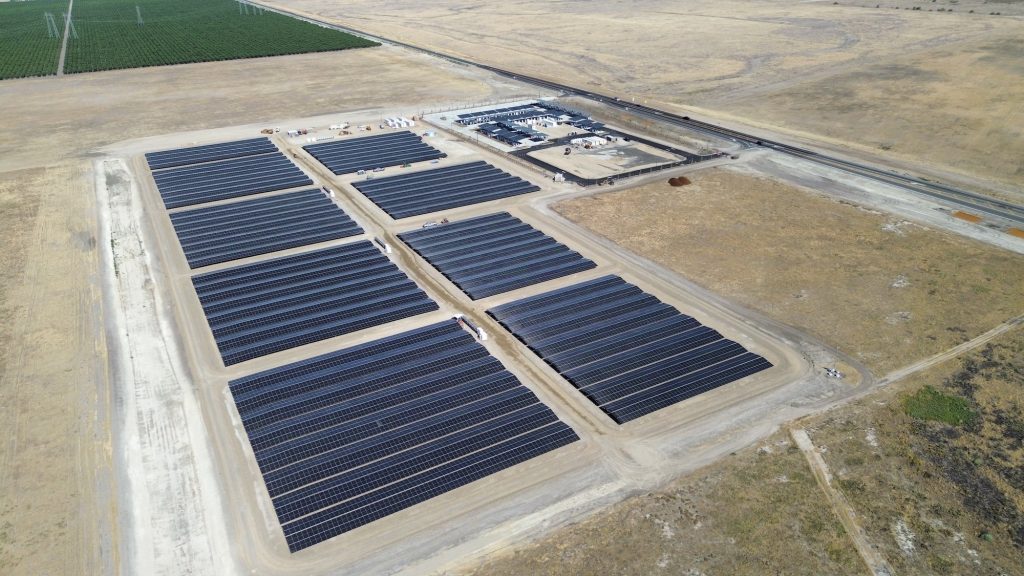
Credit: Tesla Charging | X
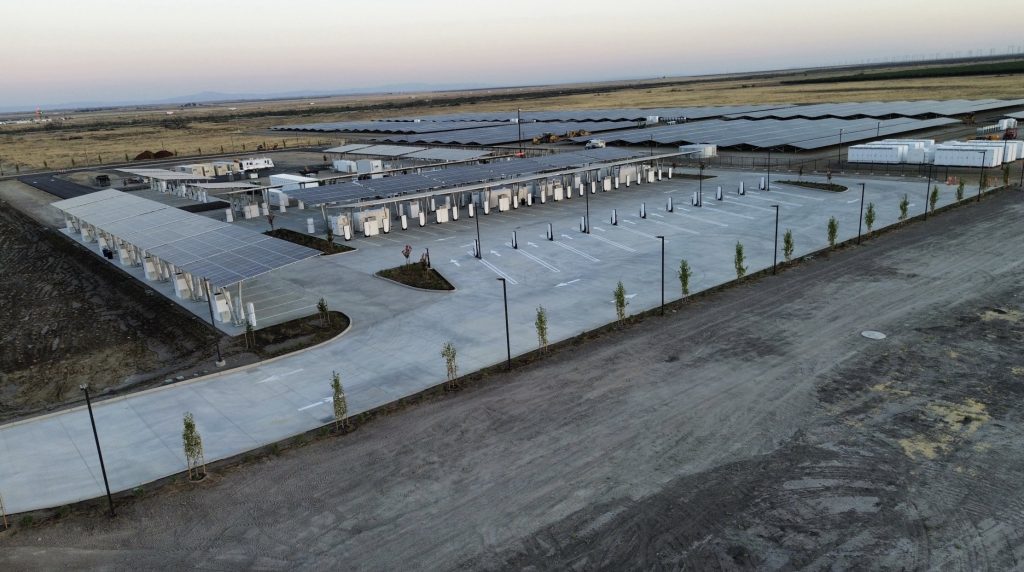
Credit: Tesla Charging | X

Credit: Tesla Charging | X

Credit: Tesla Charging | X
Tesla Supercharger Maps for North America, Europe, and Asia pic.twitter.com/0U5r0XRPyo
— TESLARATI (@Teslarati) July 2, 2025
READ MORE ON TESLA SUPERCHARGERS: Tesla launches ultra-fast V4 Superchargers in China for the first time
Testing at the LA Diner, plus Musk update on potential Tesla solar Gigafactory
The huge Tesla Supercharger station completed phase one of construction fairly quickly, especially given how long Tesla has been working on its unique Los Angeles diner, drive-in, and Supercharger location. Still, the company was seen performing some testing at the nearly-completed charging station earlier this month, and will reportedly be holding a job fair.
Elon Musk also responded on Monday morning to a post on X, suggesting that Tesla is “thinking about” building a U.S.-based solar Gigafactory in order to help support increased power needs with AI growth, and to bolster domestic solar production.
Tesla is building a new UFO-inspired Supercharger in the heart of Alien country
News
Tesla driver walks away from major accident with minor injuries
The driver sustained only minor injuries, and the exact cause of the crash remains under investigation.

The driver of a Tesla Model Y survived and walked away from a harrowing accident on Monday in California, only sustaining minor injuries despite the vehicle being impaled by a guardrail.
On Monday morning around 4:34 a.m., the Los Banos division of the California Highway Patrol (CHP) responded to the accident on I-5 near Panoche Road, involving a 23-year-old in a Tesla Model Y. According to a post on social media, the driver veered off the road for unknown reasons in the northbound lane, before crashing directly into the guardrail and impaling the vehicle.
You can read the full message and photos from Los Banos CHP below, as were shared in a Facebook post on Monday afternoon.
This morning a Tesla model y was traveling in the #1 northbound lane of I-5 north of Panoche Rd. For unknown reasons driver allowed V-1 to veer off the roadway, travel through a dirt center divide, and crashed into the fixed metal guardrail. Lucky for the driver he only sustained minor injuries and was able to walk away. Driving a vehicle requires 100% attention to the road. Avoid distractions and focus on driving.

Credit: CHP Los Banos (via Facebook)

Credit: CHP Los Banos (via Facebook)

Credit: CHP Los Banos (via Facebook)
In a statement to SFGate, CHP officer Myles Anderson said that the driver only sustained minor injuries, while no arrests are made and drugs and alcohol are not suspected to have been involved. The report also notes that Tesla’s “cruise control and lane assistance features” were activated, according to Anderson. However, it’s not entirely clear if this is referring to Supervised Full Self-Driving (FSD), or to the cruise control and lane assist features baked into Autopilot.
At the time of writing, CHP has not yet responded to Teslarati’s request for clarification and additional details on the matter.
Tesla Crash Safety Ratings across its lineup: pic.twitter.com/ny30R7ceji
— TESLARATI (@Teslarati) July 1, 2025
READ MORE ON TESLA SAFETY: Tesla rolls out crucial new safety feature aimed at saving children
The news comes after Tesla has touted its vehicles as incredibly safe for many years. In December, for example, the company highlighted receiving top safety scores from regulators on four different continents throughout the world, including from the National Highway Traffic Safety Administration (NHTSA) and the Insurance Institute of Highway Safety (IIHS) in the U.S.
Tesla has also listed the goal of making its vehicles the safest on the road throughout the years, both in the overall design of its vehicles and in its Autopilot and Full Self-Driving (FSD) programs.
Tesla Model 3 ranks as the safest new car in Europe for 2025, per Euro NCAP tests
Investor's Corner
Cantor Fitzgerald maintains Tesla (TSLA) ‘Overweight’ rating amid Q2 2025 deliveries
Cantor Fitzgerald is holding firm on its bullish stance for the electric vehicle maker.

Cantor Fitzgerald is holding firm on its bullish stance for Tesla (NASDAQ: TSLA), reiterating its “Overweight” rating and $355 price target amidst the company’s release of its Q2 2025 vehicle delivery and production report.
Tesla delivered 384,122 vehicles in Q2 2025, falling below last year’s Q2 figure of 443,956 units. Despite softer demand in some countries in Europe and ongoing controversies surrounding CEO Elon Musk, the firm maintained its view that Tesla is a long-term growth story in the EV sector.
Tesla’s Q2 results
Among the 384,122 vehicles that Tesla delivered in the second quarter, 373,728 were Model 3 and Model Y. The remaining 10,394 units were attributed to the Model S, Model X, and Cybertruck. Production was largely flat year-over-year at 410,244 units.
In the energy division, Tesla deployed 9.6 GWh of energy storage in Q2, which was above last year’s 9.4 GWh. Overall, Tesla continues to hold a strong position with $95.7 billion in trailing twelve-month revenue and a 17.7% gross margin, as noted in a report from Investing.com.
Tesla’s stock is still volatile
Tesla’s market cap fell to $941 billion on Monday amid volatility that was likely caused in no small part by CEO Elon Musk’s political posts on X over the weekend. Musk has announced that he is forming the America Party to serve as a third option for voters in the United States, a decision that has earned the ire of U.S. President Donald Trump.
Despite Musk’s controversial nature, some analysts remain bullish on TSLA stock. Apart from Cantor Fitzgerald, Canaccord Genuity also reiterated its “Buy” rating on Tesla shares, with the firm highlighting the company’s positive Q2 vehicle deliveries, which exceeded its expectations by 24,000 units. Cannacord also noted that Tesla remains strong in several markets despite its year-over-year decline in deliveries.
-

 Elon Musk1 week ago
Elon Musk1 week agoTesla investors will be shocked by Jim Cramer’s latest assessment
-

 News2 weeks ago
News2 weeks agoTesla Robotaxi’s biggest challenge seems to be this one thing
-

 News2 weeks ago
News2 weeks agoWatch the first true Tesla Robotaxi intervention by safety monitor
-

 Elon Musk1 week ago
Elon Musk1 week agoA Tesla just delivered itself to a customer autonomously, Elon Musk confirms
-

 News2 weeks ago
News2 weeks agoTesla Robotaxi rollout proves that Elon Musk still delivers, even if it’s late
-

 Elon Musk2 weeks ago
Elon Musk2 weeks agoxAI welcomes Memphis pollution results, environmental groups push back
-

 Elon Musk2 weeks ago
Elon Musk2 weeks agoElon Musk commends Tesla team on successful Robotaxi launch
-

 Elon Musk2 weeks ago
Elon Musk2 weeks agoElon Musk confirms Tesla Optimus V3 already uses Grok voice AI

















